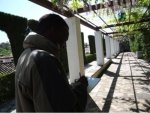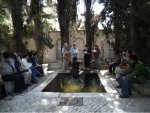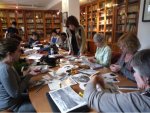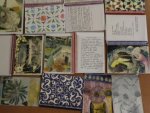accueil site > Paysage et patrimoine > 01. Teaching materials > 04. High School > From the perception of the site to landscape notebooks
- 01. Fiches pédagogiques
- 01. Teaching materials
-
02. Jardin sans frontière : une école pour développer les compétences -clés en Europe
- 04. Partenaires
- 05. Rencontres transnationales
- 14. À l’école du jardin. Mobilités de formation dans les jardins d’Europe
- 15. À l’école européenne du jardin. Paroles de formateurs sur leurs formations "entre pairs"
- 16. A l’école auropéenne du jardin. Paroles d’apprenants sur leurs mobilités Erasmus+
- 19. Petit glossaire "européen" du jardin
- 20. Dissémination
- 21. Exploitation locale du projet
- 03. Un nouvel Erasmus+ : Le bleu européen comme étendard contre l’exclusion des adultes
-
09. Erasmus+ partenariato
-
Cammini del Blu in Europa
- 01. Incontri transnazionali
- 05. Progetti blu di partners
- 10. Percorsi europei del Blu
- 20. Storie blu
- 40. Disseminazione
- 43. Transcultural Carpet Blue
- 45. Missive blu
- 46. Glossario blu
- 47. Schede didattiche "Pedagogia del colore blu in Europa"
- 48. Illustrazioni delle schede didattiche : Mostra delle opere degli studenti
-
Giardino senza frontiere. Una scuola per lo slivuppo di competenze chiave in Europa
- 04. Partners
- 05. Riunioni transnazionali
- 14. Alla scuola del giardino. Mobilità di formazione nei giardini d’Europa
- 15. Alla scuola del Giardino. Parole di formatori sul loro addestramento "tra pari"
- 16. Alla scuola del giardino. Parole dei discenti sul loro Erasmus + Mobilità
- 19. Piccolo glossario europeo del giardino
-
Cammini del Blu in Europa
-
11. Erasmus+ Partnership
- 01. Transnational Meetings
- 05. Blue Projects of partners
- 07. European roads of the Blue
- 10. Blue stories
- 40. Dissemination
- 43. Transcultural Carpet Blue
- 45. Blue Missives
- 46. Blue Glossary
- 48. Roads of the blue : the file
- 50. Illustrations of the pedagogic file : exhibition of works of learners
-
51. Garden Without Borders : A School for Developing Key Competences in Europe
- 04. Partners
- 05. Transnational meetings
- 14. At Garden School. Training mobilities in the gardens of Europe
- 15. At Garden School. Words of trainers on their "peer-to-peer" training
- 16. At Garden School. Learners’ words about their mobility Erasmus +
- 19. Small European glossary of the garden
- 20. Dissemination
-
11. Partenariats Erasmus+
-
01. Les chemins du bleu en Europe
- 01. Rencontres transnationales
- 05. Projets bleus des partenaires
- 10. Routes du Bleu en Europe ...
- 20. Histoires Bleues
- 40. Dissémination
- 43. Transcultural Carpet Blue
- 45. Missives bleues
- 46. Glossaire bleu
- 47. Formation pédagogique : fiches pédagogiques et référentiel de compétences clés et transversales
- 50. Illustrations des fiches pédagogiques : exposition des travaux des apprenants
-
01. Les chemins du bleu en Europe
- 12. Pedagogic tools
- 17. Fiches pédagogiques
- 17. Schede Pedagogiche
Paysage et patrimoine
From the perception of the site to landscape notebooks mardi 3 janvier 2012
 PROJECT A garden or a landscape is primarily a sensible and physical context. It presents itself in the form of colours, odours, sounds, tactile sensations to explore, everything which will inspire the creation of ‘carnets de jardins’ or garden logbooks.
PROJECT A garden or a landscape is primarily a sensible and physical context. It presents itself in the form of colours, odours, sounds, tactile sensations to explore, everything which will inspire the creation of ‘carnets de jardins’ or garden logbooks.
OBJECTIVES
![]() To put the sensorial exploration at stake
To put the sensorial exploration at stake
![]() To stir imagination
To stir imagination
![]() To frame the languages
To frame the languages
COMPETENCES
![]() To perceive sensations and be able to convey them by employing either the home or a foreign language
To perceive sensations and be able to convey them by employing either the home or a foreign language
![]() To be able to use the log/notebook as an instrument in itself and as a means of verbal and plastic language use
To be able to use the log/notebook as an instrument in itself and as a means of verbal and plastic language use
MATERIALS
![]() ‘Framing’ instruments of different shapes
‘Framing’ instruments of different shapes
![]() Mirrors
Mirrors
![]() Paper, notebooks, crayons, pastels
Paper, notebooks, crayons, pastels
![]() Photo cameras and drawing sticks
Photo cameras and drawing sticks
![]() Scarves
Scarves
![]() Collection boxes
Collection boxes
DEVELOPMENT
1. Gathering the sensations
Seeing
![]() To isolate some details observed in a garden or a landscape : a patio or a little bridge, the details of a statue, the veins in a stone, a paved path, the cut down branches, etc., the different perspectives that can be caught while seeing.
To isolate some details observed in a garden or a landscape : a patio or a little bridge, the details of a statue, the veins in a stone, a paved path, the cut down branches, etc., the different perspectives that can be caught while seeing.
![]() To gather the different forms which define a fruit tree garden, for example : apples, pears, plums and their different shapes : round, stretched, bobbin shaped, etc.
To gather the different forms which define a fruit tree garden, for example : apples, pears, plums and their different shapes : round, stretched, bobbin shaped, etc.
![]() In a French garden, getting aware of the regular shapes of the alleys, lawns, the symmetry of the flowerbeds, the spots of colours, the architecture, etc.
In a French garden, getting aware of the regular shapes of the alleys, lawns, the symmetry of the flowerbeds, the spots of colours, the architecture, etc.
![]() Getting aware of the details concerning the flowers when observed closely from afar or of their colour design, or the waving lines of the garden paths, etc.
Getting aware of the details concerning the flowers when observed closely from afar or of their colour design, or the waving lines of the garden paths, etc.
![]() To realize a colour board with different hues and shades to reproduce the natural hues and shades : different greens, reds getting from purple to orange, or the red of the maple tree in autumn in the Albert Kahn’s garden.
Touching
To realize a colour board with different hues and shades to reproduce the natural hues and shades : different greens, reds getting from purple to orange, or the red of the maple tree in autumn in the Albert Kahn’s garden.
Touching
![]() Wandering in the garden, blindfolded, in order to better explore and compare the tactile qualities of the elements it is composed of.
Wandering in the garden, blindfolded, in order to better explore and compare the tactile qualities of the elements it is composed of.
![]() To pick-up, classify, preserve and choose some elements to be inserted among the leaves of the notebook : soil, vegetal elements, twigs and sticks, etc.
Smelling
By the same means, getting to elaborate an olfactory notebook involving the perfume of the flowers, of particular foliage, fruits, soil, grass, etc.
The sound elements can be recorded during the same walk by using the same criteria and can constitute a catalogue of sounds to be explored, identified and classified.
2. Structuring the languages
At each stage, some words and phrases will be noted down in order to :
To pick-up, classify, preserve and choose some elements to be inserted among the leaves of the notebook : soil, vegetal elements, twigs and sticks, etc.
Smelling
By the same means, getting to elaborate an olfactory notebook involving the perfume of the flowers, of particular foliage, fruits, soil, grass, etc.
The sound elements can be recorded during the same walk by using the same criteria and can constitute a catalogue of sounds to be explored, identified and classified.
2. Structuring the languages
At each stage, some words and phrases will be noted down in order to :
![]() describe the sensations registered
describe the sensations registered
![]() express what everybody has felt.
This way of structuring the sensations will enhance mental images hitting the different languages. As a consequence, choices will be operated to create a sort of personal itinerary and build up a ‘garden notebook’.
express what everybody has felt.
This way of structuring the sensations will enhance mental images hitting the different languages. As a consequence, choices will be operated to create a sort of personal itinerary and build up a ‘garden notebook’.
FOLLOW-UP
To research the following :
![]() the history of the garden or of the landscape explored
the history of the garden or of the landscape explored
![]() the vegetation involved (trees, plants, flowers, etc.)
the vegetation involved (trees, plants, flowers, etc.)
![]() the animals living there
To build up scale models, paint or draw on the themes related.
the animals living there
To build up scale models, paint or draw on the themes related.
EVALUATION
It will rest on the relevancy of
![]() the elements gathered
the elements gathered
![]() the project of the notebook as a plastic and literary realization
the project of the notebook as a plastic and literary realization
![]() the structural coherence between text and image,
the structural coherence between text and image,
Aline Rutily, Association ‘Paysage et Patrimoine sans Frontière’















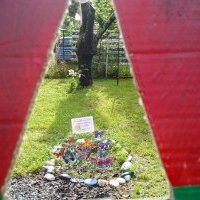


 Version imprimable
Version imprimable